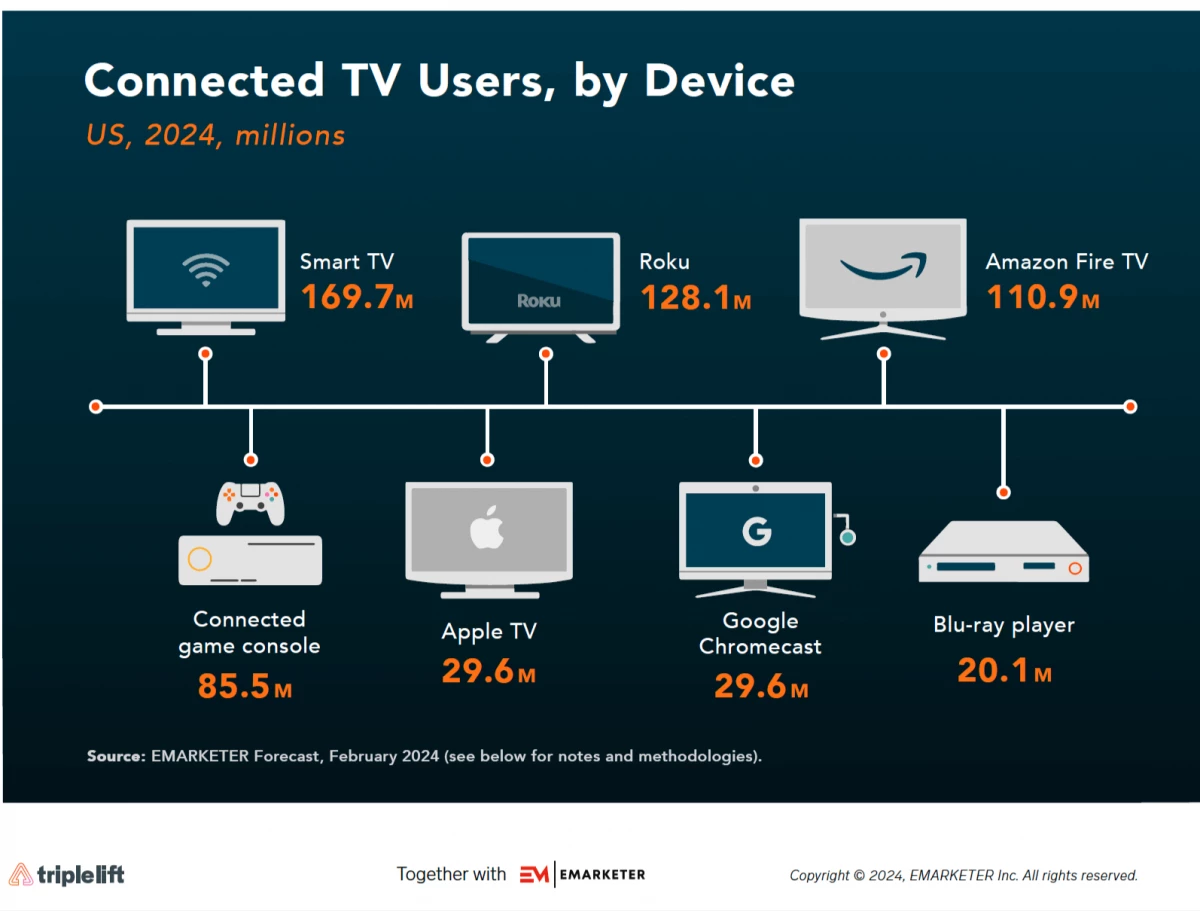WHAT IS CTV?
Did you know that technically, Connected or Converged TV (CTV) started in the 1990s with TIVO recorders? It took off in the 2000s when Netflix and Hulu started offering on-demand content.
CTV refers to any television that is connected to the internet and used to stream video. This includes smart TVs and TVs connected through external devices like TV sticks and gaming consoles. While smart TVs can access the internet directly, devices such as Amazon Firestick, Roku, Xbox, and the like are also used to stream video content on a TV.
CTV delivers streaming video inventory across ad-supported platforms such as Hulu, Peacock, Discovery+, Fubo, Freevee, Prime—the list goes on. When streaming video is accessed programmatically, advertisers can leverage precise targeting, and measurement benefits unavailable in traditional TV buys.
According to the TTD/Intelligence, Open Internet Report October 2023, 43% of Americans spend more time on streaming platforms where more of their favorite content is on CTV.
TRADITIONAL VERSUS CTV ADVERTISING
The difference between CTV and Traditional Television is the delivery method for viewers. Linear TV is accessed through satellite or cable service, while CTV is digital through the Internet.
An eMarketer/Insider Intelligence report shared that ad-supported streaming audiences passed cable TV in 2022. By 2027, AVOD viewers will be 2x that of pay TV viewers.
The difference for advertisers lies mainly in the targeting ability. Linear TV can reach an audience type but cannot drill down to a specific viewer. CTV offers more viewing options not available with traditional TV programming.
The data provided by CTV is the key to the growth in advertising through this channel. CTV platforms give advertisers specific metrics from their chosen audience related to their viewing habits, engagement, and, most importantly, ad performance. Linear TV just can’t offer this type of detail.
HOW ADVERTISERS BUY CTV?
Advertisers can purchase CTV through three main channels: programmatic platforms, CTV device makers, and streaming services.
Programmatic platforms allow advertisers to bid for ad space across various app inventories and are a key channel for purchasing CTV ad space. This method may offer lower prices and deeper reach but can provide less transparency into exactly where the ads are served.
CTV can also be purchased through device makers like Roku, Vizio, or Fire TV, which allows access to many apps and device screens.
Buying CTV through streaming services provides direct buying with exclusive ad inventory. Examples would be Disney+, Hulu, and Peacock.
A recent survey from The Trade Deck Intelligence & Advertiser Perceptions found that 95% of advertisers will maintain or increase their share of spend on CTV in 2024.
CTV BENEFITS
Similar to traditional TV, CTV boosts high-level household brand awareness in a living room setting. Beyond traditional TV's capabilities, CTV leverages programmatic benefits to reach the right people and track direct impact.
The way CTV is set up caters to the threat of 3rd party cookies going away. Logging into CTV creates an authenticated channel with verified users. This accuracy in user identification leads many advertisers to consider CTV the best way to reach their customers.
CTV advertising provides detailed analytics, including reach, frequency, ad completion rates, and performance metrics tied to business outcomes (e.g., website visits and purchases). CTV advertisers have found improved ROI and ROAS, enhanced control of ad frequency, and easier campaign optimization, providing a solid return on investment and boosting advertisers' confidence in this medium.
CTV leans towards top-of-funnel marketing, boosting high-level brand awareness. The immersive nature of CTV ads can drive strong brand recall and engagement, as ads are often non-skippable and presented in a full-screen format. This medium is highly effective for storytelling and critical for building a solid brand presence.
Live sports have been a major focus for CTV advertisers and publishers this year. With a highly engaged audience and more live sports being streamed today than in the past, live sports have become a valued part of advertisers’ media mix modeling.
IAB (Interactive Advertising Bureau) survey of advertisers recently found that 65% consider CTV a “must buy” over all other video ad formats.
CHALLENGES OF CTV ADVERTISING
Even with all of the benefits of advertising through CTV there is no perfect system.
Advertisers and their media buyers have plans for what audience to reach, how, and where. However, their chosen platforms may have limited inventory for their preferred audience, or they may encounter frequency issues.
There is also the issue of too much frequency. Advertisers must be cautious of where their ads are being delivered if buying CTV through more than one means – such as using more than one DSP.
Recent reports show that ad oversaturation turns viewers off, and they may be less likely to purchase from brands whose ads show too often. Advertisers should be sure to isolate where their ads are being shown to prevent oversaturation and bidding against themselves.
As the streaming TV landscape has evolved, nearly all services now offer some form of ad-supported content. Currently, the only service that does not offer an ad-supported tier is Apple TV+.
While most streaming services offer an ad-supported option, many viewers will always be willing to pay to avoid seeing ads. Advertisers should consider the number of viewers who opted into ad-supported streaming, the targeting options available, and the quality of the ad-viewing experience when planning for CTV.

THE FUTURE OF CTV
Improved signal reliability will present more accurate and complete data to identify users and their behavior. The better it gets, the better the reliability of audience targeting will be for advertisers.
Superior results from advertising will lead to better-targeted ads and a more highly engaged audience.
Publishers are sharing more of their content data to allow digital advertisers to customize their ad messaging and placement based on an advanced understanding of viewers.
The Trade Desk Intelligence Report for 2024 outlined the trend of shopper data and its effect on the future of CTV. With more retailers and the growth of retail media networks, the abundance of detailed user data for programmatic advertising is set to increase the accuracy and detail of CTV advertising.
Looking ahead, interactive advertising will transform the CTV advertising landscape. This will include options for viewers to choose what they see, the ability to show ads when viewers pause the screen, shoppable ads, and in-ad QR codes. Picture-in-picture ads can lead to less disruption of a viewer’s content, enhancing the overall viewing experience.
While Linear TV is still the go-to for advertisers, more brands are including CTV in their media mix. At some point in the not-so-distant future, CTV viewership and the advertising that follows will likely surpass Traditional TV viewing and ad buys, opening up new and exciting opportunities for the industry.
Sources:
https://www.stackadapt.com/resources/blog/future-of-connected-tv/
Main Image Source: pexels-silverkblack-23495484 2





